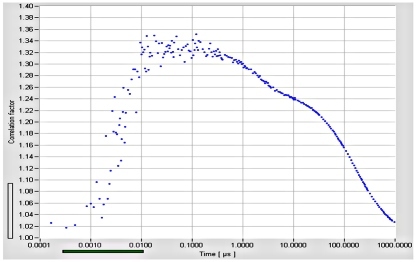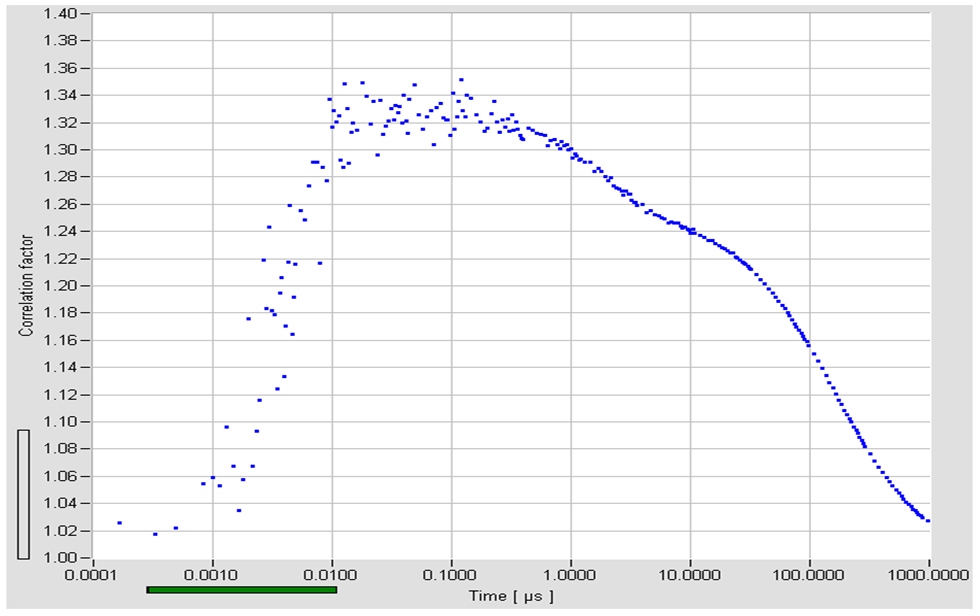
Principles
Full Correlation Down to Picoseconds
A single TCSPC channel is able to deliver FCS data down to a correlation time of the module dead time, i.e. about 100 to 125 ns. Cross correlation is obtained down to the macro time resolution, i.e. 25 to 50 ns, depending on the SPC module type.
By including the micro times, photons can be correlated down to the picosecond time scale. The principles has been introduced by Felekyan et. al. in 2005. The setup uses two synchronized TCSPC modules as shown in the figure below, left. A result is shown o the right. Fluorescence in the sample is excited by a CW laser in a femtoliter sample volume. The fluorescence light is split into two detectors, the signals of which are recorded by two TCSPC modules. The stop pulses for the time measurement come from an external 80 MHz clock generator. The internal macro time clock is synchronized to the signal at the stop inputs of the TCSPC modules. The TCSPC modules work in the parameter-tag-mode [2]; the single-photon data are constantly read by the system computer. By using both the micro times and the macro times FCS data can obtained at a resolution of about 20 ps. The algorithm is described in [1].

With slightly reduced time resolution, picosecond correlation can be achieved with the bh DPC-230 correlation module. The correlation curve is calculated online by the SPCM data acquisition software. A picosecond correlation curve recorded by a DPC-230 module shown in the figure below.

For details and more references please see:
- S. Felekyan, R. Kühnemuth, V. Kudryavtsev, C. Sandhagen, W. Becker, C.A.M. Seidel, Full correlation from picoseconds to seconds by time-resolved and time-correlated single photon detection, Rev. Sci. Instrum. 76, 083104 (2005)
- W. Becker, The bh TCSPC handbook, Chapter ‘Fluorescence Correlation Spectrocopy’, section ‘Using Micro-Time Information in Combination with FCS’
References
References Related to Full Correlation
- Al-Soufi, B. Reija, M. Novo, Suren Felekyan, R. Kühnemuth, C.A.M. Seidel, Fluorescence correlation spectroscopy, a tool to investigate supramolecular dynamics: Inclusion complexes of pyronines with cyclodextrin. J. Am. Chem. Soc. 127, 8775-8784 (2005)
- Becker, Advanced time-correlated single-photon counting techniques. Springer, Berlin, Heidelberg, New York, 2005
- Becker, Introduction to Multi-Dimensional TCSPC. In W. Becker (ed.) Advanced time-correlated single photon counting applications. Springer, Berlin, Heidelberg, New York (2015)
- Bordello, M. Novo, W. Al-Soufi, Exchange dynamics of a neutral hydophobic dye in micellar solutions studied by fluorescence correlation spectroscopy. Journal of Colloid and Interface Science 345, 369-376 (2010)
- W. Borst, S. P. Laptenok, A. H. Westphal, R. Kühnemuth,H. Hornen, N. V. Visser, S. Kalinin,J. Aker, A. van Hoek, C. A. M. Seidel,A. J. W. G. Visser, Structural Changes of Yellow Cameleon Domains Observed by Quantitative FRET Analysis and Polarized Fluorescence Correlation Spectroscopy. Biophys. J. 95, 5399–5411 (2008)
- Felekyan, R. Kühnemuth, V. Kudryavtsev, C. Sandhagen, W. Becker, C.A.M. Seidel, Full correlation from picoseconds to seconds by time-resolved and time-correlated single photon detection, Rev. Sci. Instrum. 76, 083104 (2005)
- Felekyan, Software package for multiparameter fluorescence spcetroscopy, full correlation amd multiparameter imaging. Available from www.mpc.uni-duesseldorf.de/seidel/software.htm
- Granadero, J. Bordello, M.J. Perez-Alvite, M. Novo, W. Al-Soufi, Host-guest complexation studied by fluorescence correlation spectroscopy: Adamantane-Cyclodextrin Inclusion. Int. J. Mol. Sci. 11, 173-188 (2010)
